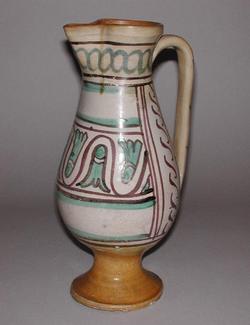Current Location: In storage
Maker(s)
Pottery:
Unidentified Orvieto pottery
Entities
Categories
Description
Late Medieval maiolica jug, painted in manganese and green with lines, leaves, S hooks and oblique stripes.
Pale buff earthenware. The interior, foot and lower part are lead-glazed brownish-yellow, the base is unglazed and the rest is tin-glazed off-white. The glaze has crazed. Painted in manganese and copper-green.
Shape 17. Elongated piriform body with pedestal foot, short neck, trilobate mouth loop handle of oval section (restored).
The panel on the front is crossed by a manganese undulating line with leaves in the spaces on either side of it; above and below, there are two manganese horizontal lines and one green, an interval and another green. The handle is flanked by S hooks between two sets of three vertical lines. Below are two manganese bands; on the neck, two manganese bands, a green chain and another manganese band. The handle has four oblique green stripes.
Notes
History note: William Ridout; Christie's, 13 December 1938, The William Ridout collection of Italian majolica, European pottery, faience and delftware, part of lot 105; H.S. Reitlinger (d. 1950); the Reitlinger Trust, Maidenhead, from which transferred in 1991.
Legal notes
H.S. Reitlinger Bequest, 1950
Measurements and weight
Height: 28.5 cm
Acquisition and important dates
Method of acquisition: Bequeathed
(1950)
by
Reitlinger, Henry Scipio
Dating
13th Century
14th Century
Medieval
Circa
1275
CE
-
1375
CE
Note
Pedestal jugs with trilobate mouths were made in Tuscany, Umbria, Lazio and Emilia-Romagna, although their proportions vary from area to area, particularly the height and width of the foot. Their decoration includes geometrical, plant, heraldic, zoomorphic and relief ornament. It is not yet clear when they were introduced or when they went out of fashion. On the basis of those found in the vault of the loggia of the Palazzo Publico, Montalcino, and the vault of the refectory of the Convent of San Francesco at Assisi, they can be dated to at least the first half of the fourteenth century. Fragments recovered from cister C of the Palazzetto Faina, Orvieto, have been dated to the late thirteenth or early fourteenth century.
School or Style
maiolica arcaica
People, subjects and objects depicted
Components of the work
Interior, Foot
composed of
lead-glaze
( and lower part)
Decoration
composed of
high-temperature colours
( manganese and copper-green)
Exterior
composed of
tin-glaze
Foot
Diameter 10.0 cm
Body
Diameter 12.9 cm
Front To Handle
Width 13.8 cm
Materials used in production
Earthenware
Inscription or legends present
Inscription present: brown tie-on
- Text: 105/18
- Method of creation: Inscribed in pencil
- Type: Label
References and bibliographic entries
Identification numbers
Accession number: C.62-1991
Primary reference Number: 47581
Packing number: EURCER 476
Stable URI
Audit data
Created: Saturday 6 August 2011
Updated: Tuesday 30 April 2024
Last processed: Wednesday 14 May 2025
Associated departments & institutions
Owner or interested party:
The Fitzwilliam Museum
Associated department:
Applied Arts





